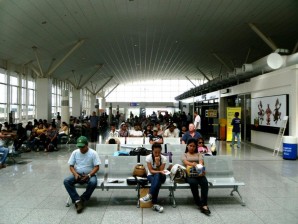Night vision gear for 14 more provincial airports

NIGHT RATED. Iloilo Airport is one of the few equipped with technology to operate at night. Photo by INQUIRER.net’s Don Lejano
MANILA, Philippines—Fourteen more provincial airports will be equipped by the end of the year with a technology that would enable them to operate even at night, Transportation Secretary Mar Roxas said Thursday.
Roxas made the announcement during the signing of the Memorandum of Agreement for the integration of the terminal fee into the airline tickets for domestic passengers.
Apart from Roxas, other signatories to the MOA were Manila International Airport Authority (MIAA) General Manager Jose Angel Honrado and officials of airline companies, like the Philippine Airlines, Cebu Pacific, Air Philippines, Seair, Zest Air and Sky Pasada.
Installation underway
Article continues after this advertisementArticle continues after this advertisement
According to Roxas, the government is now working on the installation of night-vision equipment in many provincial airports to address congestion at the Ninoy Aquino International Airport (Naia) terminals.
“Within the year, our airports in Tagbilaran, Legaspi, Dumaguete, Butuan, Ozamiz, Cotabato, Naga, Dipolog, Roxas, Pagadian, Tuguegarao, Busuanga, Surigao, and San Jose in Mindoro will all have a night vision capability,” he told reporters.
To date, only 12 airports are night-rated, he added. These include Manila, Bacolod, Cebu, Davao, General Santos, Puerto Princesa, Iloilo, Kalibo, Tacloban, Cagayan de Oro, Laoag and Zamboanga.
Domestic carriers bundle their departures during daytime so that all of them would be able to take off from their points of departure before sunset.
This has contributed to congestion and slotting problems at the Naia terminals.
“All of them are in a hurry to come back before sunset, where provincial airports stop operating due to the absence of runway lights or night-vision technology,” Roxas said in a previous interview.
He added that the night vision capability would improve visual awareness in smoky, foggy or dark environments.
With the new technology, air carriers can choose other slots or schedules so that departures are spread out evenly, thus avoiding congestion.
Airline companies said they support the government’s plans to ease congestion, including rescheduling some flights to off-peak hours, thus increasing runway capacity.
Cebu Pacific Air president and chief executive officer Lance Gokongwei said they also welcome proposals to transfer general aviation operations to other airports.
“This airport (Naia) is used both by commercial aviation and general aviation, including private planes and training schools, which constitute about 17 percent of all movements in Manila. It’s probably better to use it for tourists and bigger aircraft which can carry more passengers,” said Gokongwei.